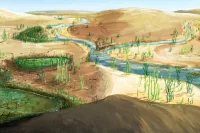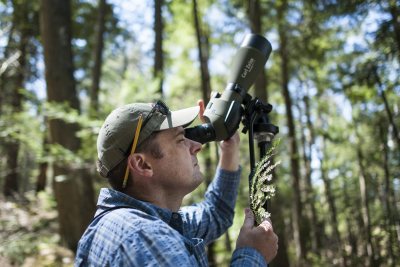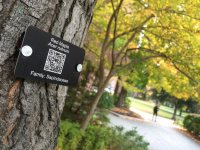
$165,000 grant funds Bates study of tree structure and drought response
It’s pretty plain that sooner or later, a tree without water will die.
What’s not so clear is exactly what happens inside a thirsty tree while it’s still alive. In particular, what happens within the xylem — the dense, complex system of tiny interconnected conduits that convey water and nutrients from the roots to the farthest leaf tips.
As drought related to climate change increasingly confronts the world’s forests, scientists feel a great urgency to better understand how this life-sustaining system fares during dry times.

A sample of tree xylem tissue represented in a 3-D micro-CT scan (top) and in models made by a 3-D printer. (Craig Brodersen)
Thanks to a grant of nearly $165,000 from the National Science Foundation, a member of the Bates biology faculty is poised to do just that. This summer, Brett Huggett and a research team including a Bates student will start a three-year study of the xylem networks of four tree species common in the Northeast.
“Our goal in this study is to really understand the three-dimensional anatomical structure of the xylem network and its function in response to drought,” says Huggett, a plant physiologist in his second year at Bates.
Even in traditionally moist New England, the threat from climate change-related drought “is a serious concern,” Huggett says. “If we have increased occurrences of drought, we may have certain tree species dying or suffering reduced growth rates.”
Huggett is collaborating with Craig Brodersen, assistant professor of plant physiological ecology at the Yale School of Forestry and Environmental Studies. Taking cores and other samples from living hardwood trees, they will analyze growth rings to model xylem structure and function in three dimensions — and they’ll correlate these models with historic weather records to determine how xylem networks function respond to drought.
The field work will take place in the Harvard Forest, a research facility in the central Massachusetts town of Petersham. Huggett and Brodersen will examine 24 specimens apiece of American ash, red oak and red maple — all common, and commercially valuable, species in Maine and elsewhere — as well as sweet birch.
“We’ll also install a three-year garden plot where we’ll grow the four species in a controlled-drought experiment,” Huggett says, with a “rainfall exclosure system to reduce water availability to certain specimens.”
The project has three goals: first, to determine which of the four species are most resilient during a drought; second, to establish for each species tipping points beyond which typical specimens can’t recover from drought; and finally, to develop means for predicting widespread tree mortality.
Another planned outcome of the project is an online database from which xylem models can be downloaded for three-dimensional printing — a great tool for teaching wood anatomy, a topic that’s otherwise fairly hard to get across to students. (Those models will be made possible by the work of a Bates student who will travel to the University of California, Berkeley, to learn to scan xylem tissue with micro-computed tomography technology.)
Huggett and Brodersen will work with one undergraduate each from Bates and Yale, supported by Harvard Forest’s Summer Research Program for Undergraduates. A postdoctoral research associate from Yale will also take part.
Forest vulnerability to drought is a concern from both the conservation and commercial perspectives. “Being able to identify which species might succumb to drought earlier than others, or which trees might be more adaptable, will be important to making decisions” about forest management and conservation strategies, Huggett explains.

Assistant Professor of Biology Brett Huggett holds a hemlock branch infested with invasive hemlock woolly adeljids during a Short Term 2015 field trip at the Bates–Morse Mountain Conservation Area. (Josh Kuckens/Bates College)
Bates’ share of the grant from the National Science Foundation’s Division of Integrative Organismal Systems is $164,704, while $463,788 is destined for Yale.
For Huggett, the most rewarding aspect of the grant is the support it will provide over three years for Bates student researchers, rising seniors who will be able to parlay their work into a senior thesis project.
By the same token, he is pleased to give his students an entrée to the Harvard Forest summer research program — “which is just a tremendous program,” he says.
Providing room, board, and a stipend, the 11-week program brings together students from all over “in a really vibrant, collaborative research community,” Huggett explains.





